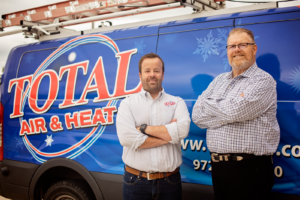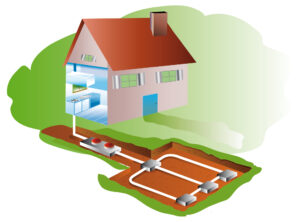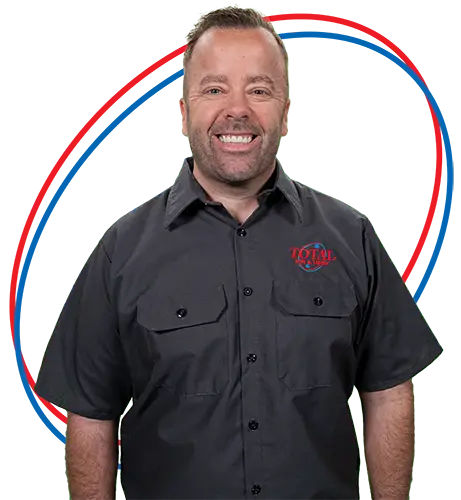What are the four basic types of heat pumps?
Let’s be honest—heat pumps aren’t something most folks sit around thinking about. Until yours stops working or your energy bill hits the roof. That’s when we get the call.
At Total Air and Heat, we’ve helped homeowners for decades find the right setup to keep their homes cool in summer and warm in winter. And when people ask, “What are the four types of heat pumps?”—we don’t throw out buzzwords or fluff.
We break it down like we’re talking to a neighbor across the fence. Because we are your trusted next-door neighbor for 65 years.
The 4 Types of Heat Pumps
Heat pumps work by moving heat instead of creating it. They can pull heat from the air, the ground, or water and move it inside or out, depending on the season. Here are the four main types you’ll run into:
1. Air-Source Heat Pumps
This is the most common type, and chances are, if you’ve got a heat pump now, it’s this kind.
How it works: It pulls heat from outside air and brings it inside during the winter. In the summer, it does the opposite—it moves indoor heat outside.
Best for: Mild to hot climates like Texas. With newer technology, they even work well during chilly spells.
Why people like them: They’re affordable to install and maintain. They work well with existing ductwork. They’re energy-efficient and can heat and cool with a single system.
2. Ductless Mini-Split Heat Pumps
No ducts? No problem. Mini-splits are great for additions, garages, older homes, or rooms that always seem too hot or too cold.
How it works: Similar to an air-source heat pump, but instead of pushing air through ducts, it uses individual wall-mounted units connected to an outdoor compressor.
Best for: Homes without ductwork, room additions, or zoned temperature control.
Why people like them: Easy installation, quiet operation, and zoned comfort. You can control each room individually.
3. Geothermal Heat Pumps (Ground-Source)
These use the steady temperature underground to heat and cool your home.
How it works: Pipes are buried in your yard. The system pulls heat from the ground in winter and dumps heat there in summer.
Best for: Homeowners with enough yard space or those planning to stay in the same house for years.
Why people like them: Lower operating costs over time and incredible efficiency. But they’re a bigger investment upfront.
4. Water-Source Heat Pumps
These aren’t as common for residential use but can be found in condos, large buildings, or homes near a pond or lake.
How it works: Pulls heat from a water source (like a well or body of water) and transfers it indoors or outdoors.
Best for: Properties with consistent water temperatures and access to a reliable water source.
Why people like them: Steady performance and efficiency when installed correctly—but location is everything.
When to Call for Professional Help
We’ve seen heat pumps get ignored until the thermostat flatlines. Don’t wait that long.
Here’s when to pick up the phone:
- Your heat pump runs constantly but never quite cools or heats the house.
- Your energy bill jumped without any real change in usage.
- You hear strange noises—buzzing, rattling, or grinding.
- Your heat pump freezes over, even in summer.
- You see water leaks or moisture around the system.
- Airflow feels weak or rooms are uneven in temperature.
- You can’t remember the last time it was serviced.
We send out our Eagle-Eyed Techs to find the issue fast and get things back on track. We look for more than just the obvious. Our team knows what signs to catch before they turn into expensive breakdowns.
Our Process: What Happens When We Visit
Every visit starts with a question: “What’s the house been doing lately?” Then we get to work.
Here’s what we do:
- Inspect the Unit: We check refrigerant levels, coils, fans, sensors, and motors.
- Test the Thermostat: We make sure it’s responding and communicating with the system.
- Look at Airflow: Dirty filters or blocked ducts? We find the bottlenecks.
- Clean Coils and Drains: Grime buildup cuts performance. We scrub it out.
- Measure Output: We track temperature change and make sure the heat pump is pulling its weight.
- Talk it Through: We show you exactly what we found. No guesswork. No pressure sales.
And if it’s time for your yearly service, we’ll roll everything into our Tip Top Tuneup—a full system check that gives your heat pump a fresh start for the season.
FAQ
Do all heat pumps work in both heating and cooling modes?
Yes. Every type listed here heats and cools. That’s the main draw of a heat pump system—it pulls double duty year-round.
Can I replace my AC with a heat pump?
Absolutely. Especially if you already have ductwork. A heat pump gives you both heating and cooling in one shot.
Is a geothermal system worth the cost?
It can be—especially if you plan to stay in your home long-term. Lower operating costs add up over time.
How often should I service my heat pump?
Once a year. We recommend spring or early fall. That’s when problems hide and performance drops off.
Can I install a mini-split heat pump in just one room?
Yes, and many people do. It’s perfect for a sunroom, garage apartment, or home office that never feels right.
Let’s Get You the Right Heat Pump
Picking the right heat pump isn’t about guessing. It’s about asking the right questions and listening to what your house needs. That’s where we come in.
At Total Air and Heat, we don’t show up with a script—we show up with experience, tools, and a promise to do the job right. We’re not comfortable until you are. Give us a call. Let’s figure out what kind of heat pump fits your space and keeps your home just the way you like it.

